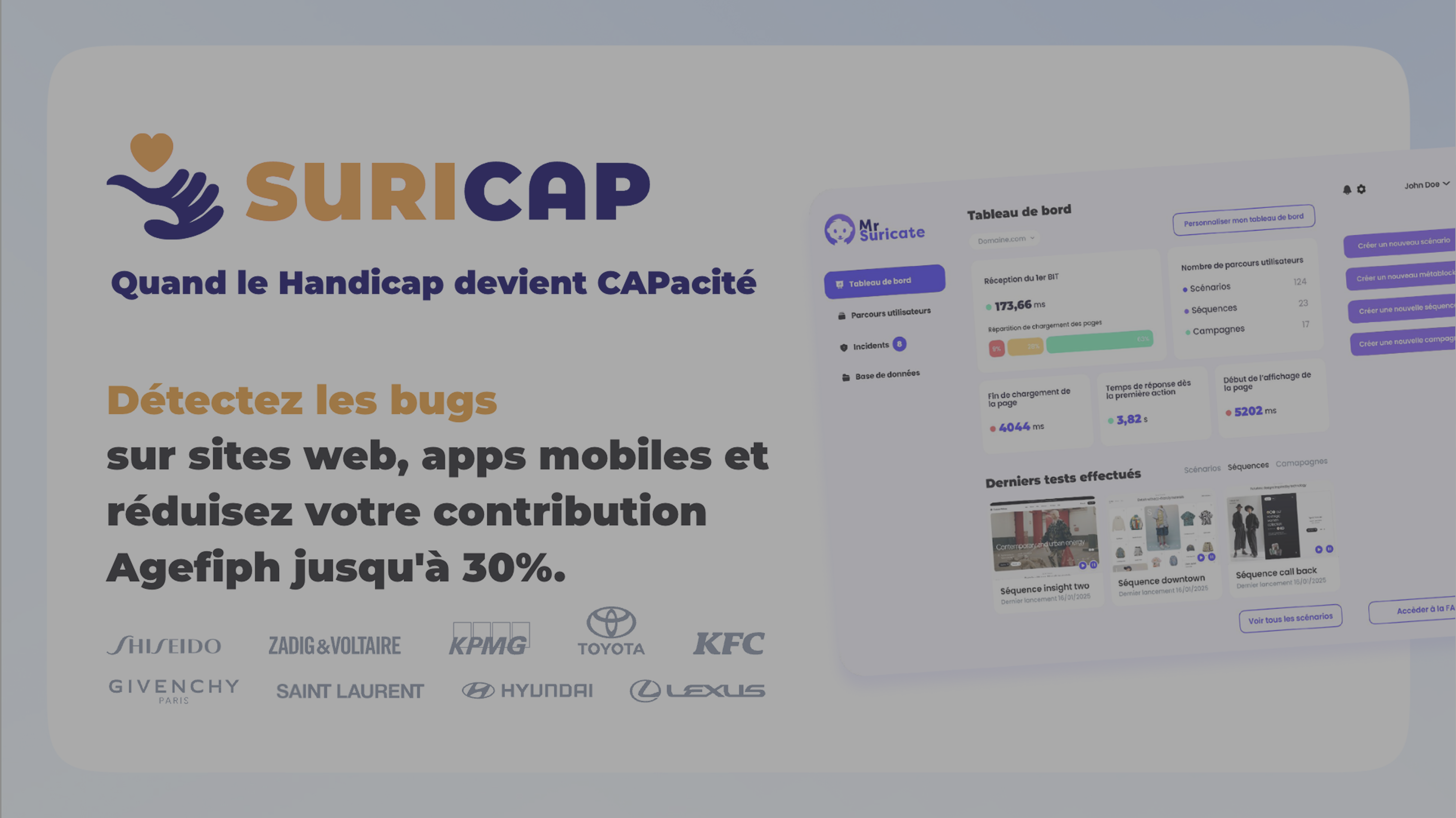Best tools for digital accessibility: our 2025 selection
Making your website accessible to all users, including people with disabilities, is essential for both moral and legal reasons.
However, with so many elements to consider, it's easy to miss key issues.
Compliance requirements can be confusing between the multiplication of standards(RGPD, WCAG, ISO, etc.), regular updates, and sometimes unclear interpretations depending on the sector.
This is why accessibility testing tools are indispensable for detecting these problems and proposing concrete solutions to both improve the user experience and meet compliance standards.
In this article, we'll share a slightly subjective list of what we consider to be the best tools fordigital accessibility.
What do accessibility tools actually test?
In addition to screen readers and color contrast analyzers (which we list at the end of this article and whose names are self-explanatory), most accessibility tools test :
- The semantic structure of the page (titles, HTML tags, logical hierarchy)
- The presence of relevant alternative texts for images
- Keyboard navigation (without mouse) and visible focus
- Color contrast between text and background
- Clear identification of interactive links and buttons
- Correct use of ARIA roles for assistive technologies
- Mobile compatibility and responsive adaptability
- Code errors that may interfere with reading by assistive tools
These tools can quickly detect obstacles to accessibility, but are no substitute for a full human evaluation to assess the clarity of content or the coherence of the user experience.
1. Mr Suricate - automating accessibility testing for continuous compliance
Thanks to its AI-enhanced continuous monitoring technology, Mr Suricate can quickly detect accessibility violations before they affect the user experience or the site's legal compliance.
By reproducing accessible user paths and identifying anomalies in real time, Mr Suricate ensures that your platform remains inclusive, ergonomic and compliant with international standards.

Thanks to its automatedaccessibility tests, Mr Suricate offers proactive management with instant alerts as soon as a problem is detected.
Key benefits
✅ Continuous monitoring to identify anomalies that could degrade accessibility and user experience.
✅ Intuitive interface and detailed reporting.
✅ Personalized support.
✅ Ease of use, even for non-technical teams.
✅ Seamless integration with your development tools, CI/CD and content management systems.
Disadvantages
❌ Solution specialized primarily for technical detection and correction, not inclusive UX strategy support.
2. DevTools axis - for integrating accessibility into your development workflow
axe DevTools is a browser extension enabling developers to integrate accessibility testing directly into their working environment.
The tool automatically detects compliance errors (WCAG 2.1, WCAG 2.2) and offers recommendations for correcting them.
By integrating with browsers and CI/CD processes, this solution facilitates the adoption of accessibility right from the development phase.
Key benefits
✅ Precise recommendations with practical guides for correcting detected errors.
✅ Native integration in Chrome, Firefox and Edge browsers.
✅ Ability to integrate into CI/CD pipelines for continuous accessibility testing.
✅ Compatible with automation tools such as Selenium and Cypress.
Disadvantages
❌ Requires a technical understanding of accessibility to interpret some advanced results.
❌ The free version is limited to manual analysis.
3. WAVE: rapid visual analysis to detect accessibility errors
WAVE is one of the best-known tools for rapid visual analysis of website accessibility.
Accessible directly via a browser extension or online, the tool identifies accessibility errors while superimposing annotations on the analyzed page.
With its intuitive presentation, WAVE makes it possible to analyze every page of a site and immediately understand where the obstacles to inclusive navigation lie.

Key benefits
✅ Visual, educational interface.
✅ Extension available free of charge on Chrome, Firefox and Edge.
✅ Offers explanations of every error identified.
✅ API available for projects requiring large-scale analyses (with license).
Disadvantages
❌ Limited to analyzing individual pages (no native multi-page automation without a paid API).
❌ Does not detect all dynamic problems (accessibility of modified elements via JavaScript, for example).
4. Siteimprove: collaborative management of digital accessibility
Siteimprove is a platform that helps companies manage the overall quality of their digital presence, and digital accessibility is a natural part of this.
It is designed to foster collaboration between marketing, development and compliance teams, and offers continuous monitoring and prioritization of corrective actions with this centralized approach.
With its intuitive dashboard, Siteimprove facilitates a global understanding of a site's accessibility, and supports teams towards sustainable improvement.

Key benefits
✅ Clear dashboard to track accessibility over time.
✅ Collaborative tool suitable for large multidisciplinary teams.
✅ Possible integration with CMS, content management platforms and analysis tools.
✅ Access to educational resources to improve accessibility skills.
Disadvantages
❌ Requires organizational commitment to fully exploit all features.
❌ More expensive and cumbersome solution for small projects or simple sites.
5. Pa11y - open-source accessibility test automation
Pa11y is a powerful open-source tool for automating accessibility testing on websites and applications.
Designed for easy integration into development pipelines (CI/CD), the tool enables technical teams to detect violations of WCAG standards early and systematically.
The solution is particularly well-suited to projects requiring regular testing on numerous environments, while retaining configuration flexibility.
Key benefits
✅ Fully open-source tool, with no license fees.
✅ Ideal for automating testing in CI/CD pipelines (Jenkins, GitLab, etc.).
✅ Flexibility to adapt to the specific needs of each project.
✅ Usable report generation for tracking accessibility over time.
✅ Suitable for both simple page testing and complex user journeys (with Pa11y CI).
Disadvantages
❌ Requires technical skill for initial setup.
❌ Limited user interface.
6. Screen readers - testing the real accessibility of content
Screen readers enable blind and partially-sighted people to interact with digital content by transforming on-screen text into text-to-speech or digital Braille.
Using a screen reader in tests can detect problems that conventional automated tools fail to see, such as poor content prioritization or lack of navigation cues.
Recommended screen readers include :
- NVDA (Windows): Very popular free reader, ideal for quick tests.
- JAWS (Windows): Professional solution, widely used in companies (fee-based).
- VoiceOver (macOS and iOS): Free integrated player on all Apple devices.
- TalkBack (Android): Native screen reader for Android smartphones and tablets.
These tools can be used to test ergonomics, navigation fluidity, keyboard-only use, and understanding of structured content (headings, lists, links, forms).
Key benefits
✅ Validate the real user experience for the visually impaired.
✅ Detect accessibility issues not visible through automated testing.
✅ Accessible free of charge for the majority of testing needs (NVDA, VoiceOver, TalkBack).
✅ Essential for testing keyboard navigation and accessibility shortcuts.
Disadvantages
❌ Require learning time for effective use.
❌ Screen reader tests should be performed as a complement to automated tests, not as a replacement.
7. Color Contrast Analyzers - ensuring optimum legibility for everyone
Insufficient contrast can make reading difficult or even impossible for the visually impaired or color-blind.
Color Contrast Analyzers are essential tools for checking that color contrasts between text and background comply with accessibility standards (WCAG 2.1).
They can be used to quickly identify legibility problems and correct color choices in web and mobile interfaces.
Recommended tools include :
TPGi Color Contrast Analyzer : Free application available for Windows and Mac, for testing the contrast of any screen element.
Contrast : simple application for Mac, dedicated to designers and developers, to check contrast ratios with a single click.
Key benefits
✅ Fast, reliable verification of text/background contrasts in compliance with WCAG standards.
✅ Simulation of different types of visual impairment (color blindness, low vision).
✅ Lightweight, free and easy-to-use tools.
✅ Ideal for integrating contrast verification right from the design phase.
Disadvantages
❌ Obviously limited to contrast analysis only.
Ensure your digital accessibility with Mr Suricate !
Mr Suricatewith its advanced automated testing solutions and proactive expertise, is the partner of choice for companies wishing to ensure the accessibility of their online services.
By adopting a rigorous, ongoing testing strategy, companies can not only comply with standards, but also improve the user experience for all their customers, strengthening their reputation and commitment to social responsibility.




